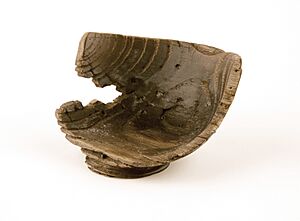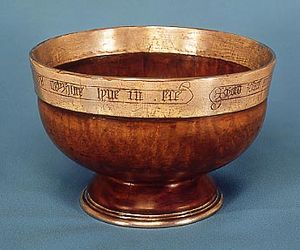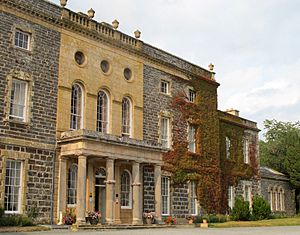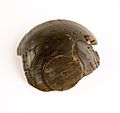Nanteos Cup facts for kids
Quick facts for kids Nanteos Cup |
|
|---|---|

The Nanteos Cup, photographed in 2016
|
|
| Material | Hardwood (wych elm) |
| Size | ⌀ 12 cm |
| Created | 14th–15th century |
| Discovered | c.1878 Strata Florida Abbey, Ceredigion, Wales 52°16′30″N 3°50′22″W / 52.275104°N 3.839376°W |
| Present location | National Library of Wales, Aberystwyth |
The Nanteos Cup (Welsh: Cwpan Nanteos) is an old wooden bowl from the Middle Ages. For many years, it was kept at Nanteos Mansion, a large house near Aberystwyth in Wales.
People have believed since the late 1800s that the cup has special powers to heal sick people who drink from it. It was also traditionally thought to be made from a piece of the True Cross, which is believed to be the cross Jesus was crucified on. By the early 1900s, the Nanteos Cup became one of many objects thought to be the Holy Grail, a legendary cup from the stories of King Arthur. However, experts like Juliette Wood, who studies old stories, say there isn't much proof about the cup before the late 1800s, and no one linked it to the Grail until 1905.
In 1977, the cup was shown at the National Library of Wales in Aberystwyth. Experts who looked at it said it was made from wych elm wood and dated back to the Late Middle Ages (around the 14th or 15th century). In 2014, the cup was stolen from a house in England but was found and returned in 2015. After its recovery, the owners placed it permanently at the National Library of Wales, where you can see it today.
Contents
What is the Nanteos Cup?

The Nanteos Cup is a shallow, round bowl made of hardwood. It doesn't have handles and has a flat base. It was originally about 10 centimeters (4 inches) tall and 12 centimeters (5 inches) wide. Over time, it has been damaged, and now less than half of the original bowl remains.
Unlike some other old bowls of its type, called "mazers," it doesn't have a raised part in the middle. It's made from wych elm wood and has no decorations. There's a small groove around the edge, which might have once held a metal rim.
How the Cup Became Famous
The Nanteos Cup was first shown to the public in 1878 by George Powell. He had inherited the Nanteos estate and the cup. He displayed it at a meeting of a history group in Wales.
At this meeting, George Powell explained that the cup had been kept at Nanteos for many years. He said it was once owned by Strata Florida Abbey, an old monastery. People believed it had amazing healing powers. They would send for the cup when someone was sick, and the patient would drink wine or other liquids from it. Sometimes, people even bit off pieces of the cup, which is why it's so damaged today.
It was thought that the cup's healing powers came from it being part of the True Cross. Historians believe it's very likely that the monks at Strata Florida Abbey kept it as a special religious item with healing abilities. People in the area valued it so much that they probably helped save it from being destroyed when monasteries were being closed down.
Experts identified the cup as a wooden mazer from the Middle Ages. A drawing from that time shows the cup already damaged and held together with metal clips. Before 1878, there isn't much written proof about the cup. Some experts think it might have been found during archaeological digs at Strata Florida Abbey around the time George Powell was making repairs there.
Over the next 20 years, the cup became more widely known. Newspapers started reporting on its legend, adding details about its healing powers, especially for certain illnesses. This interest grew partly because of new books and poems about the Arthurian legends and the Holy Grail, like Alfred, Lord Tennyson's Idylls of the King.
The Holy Grail Connection
In the early 1900s, a local historian named George Eyre Evans worked to protect the ruins of Strata Florida Abbey. He organized tours to the site, and during one tour in 1901, he also arranged for visitors to see the Nanteos Cup at Nanteos Mansion.
One visitor, Ethelwyn Mary Amery, was so impressed that she declared the cup to be the Holy Grail. In 1905, she published a booklet called Sought and Found: A story of the Holy Grail. In it, she shared a story she said she heard at Nanteos. The story claimed that during the time of King Henry VIII, when monasteries were being closed, seven old monks from Strata Florida Abbey fled with their treasure, which was the cup. They found shelter at Nanteos, and the last monk entrusted the cup to the family living there.
There are different versions of this story, some saying the monks came from Glastonbury. However, historians say there's no proof that the cup was ever at Strata Florida Abbey as a relic or that it was connected to Glastonbury. Also, the Nanteos estate was established much later than when the monasteries were closed. Experts believe the story about the monks fleeing with the cup was likely made up to connect it to the Holy Grail legend.
Despite this, the story helped make the Nanteos Cup very famous. It brought a lot of public interest to Strata Florida Abbey, helping to ensure the ruins were protected and studied more closely. In 1909, George Eyre Evans held a big event at the abbey where the Nanteos Cup was displayed. It's said that when the cup was brought out, the clouds parted, and the sun shone through, adding to its magical reputation.
The Cup in Popular Culture
The Nanteos Cup has appeared in various media. Some people claimed that the German composer Richard Wagner visited Nanteos and was inspired by the cup's legend to write his opera Parsifal, which is about the Holy Grail. However, there's no record of Wagner ever visiting Nanteos.
The cup was also featured in a TV documentary called The Search for the Holy Grail: The True Story. In the program, experts confirmed that the wood of the cup dates from the 14th century, much later than the time of the crucifixion. They also confirmed it was a mazer bowl made of wych elm, not olive wood. Another documentary, The Making of King Arthur, also showed the cup, with its current owner being interviewed.
The Cup is Stolen and Found
In July 2014, the Nanteos Cup made headlines when it was stolen from a house in England. The cup had been lent to a sick woman who had family ties to the owners. It was believed to have been taken while she was in the hospital. Police joked that they were "hunting the Holy Grail."
After a search, the cup was found and recovered on June 19, 2015. Police were contacted by an anonymous person, and the cup was handed over in a pre-arranged meeting. No arrests were made. Following its recovery, the owners decided to place the Nanteos Cup in the care of the National Library of Wales, where it is now on permanent public display for everyone to see.
Images for kids
See also
 In Spanish: Vaso de Nanteos para niños
In Spanish: Vaso de Nanteos para niños





